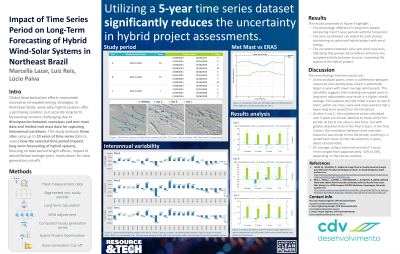Back

Impact of Time Series Period on Long-Term Forecasting of Hybrid Wind-Solar Systems in Northeast Brazil
Tuesday, October 1, 2024
5:00 PM – 6:00 PM MST
Location: Regency D


Marcella P. Lazar (she/her/hers)
Project Engineer
Casa dos Ventos
Fortaleza, Ceara, Brazil
Poster Presenter(s)
Presentation Description: In the face of urgent global demands for decarbonization, transitioning towards a more sustainable energy matrix necessitates innovative strategies to maintain energy supply while reducing reliance on fossil fuels. In Brazil, the complementarity between wind and solar sources emerges as a viable solution to ensure the continuity of energy supply to consumers, offering a way to optimize connection costs to the system. The main methodological challenge lies in accurately modeling the ideal complementarity between these sources to obtain a reliable long-term forecast. This complexity arises because, on an hourly basis, reanalysis datasets diverge considerably from the data obtained through met masts. On the other hand, typically, there is not enough data obtained through met masts to accurately represent interannual variations. This study aims to analyze three sites in two states of the Brazilian Northeast, utilizing time series data measured for up to 10 years. The results indicate that the selected period, along with the duration and the quality of the analyzed years (whether they were above or below the regional historical average), significantly influences the calculation of the cut applied to solar generation, potentially leading to biased results.
